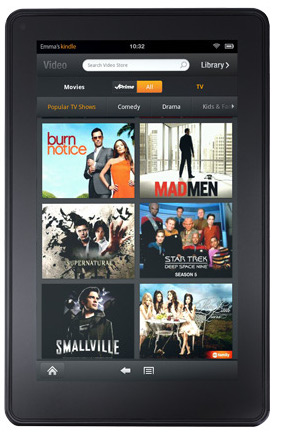Review: Amazon’s Kindle Fire isn’t really a tablet
Nov 16, 2011 — by LinuxDevices Staff — from the LinuxDevices Archive — 2 viewsAmazon's Kindle Fire is the world's smallest vending machine disguised as a tablet. In other words, according to this eWEEK review, it's really a dedicated media device, not something you should expect to use for work.
 The seven-inch Kindle Fire is less a tablet in the mode of Apple's iPad or Samsung's Galaxy Tab 10.1, and more a touch-screen portal to Amazon's online storefront, with its massive collections of streaming video, music and e-books. It also plays any music uploaded through Amazon's Cloud Drive.
The seven-inch Kindle Fire is less a tablet in the mode of Apple's iPad or Samsung's Galaxy Tab 10.1, and more a touch-screen portal to Amazon's online storefront, with its massive collections of streaming video, music and e-books. It also plays any music uploaded through Amazon's Cloud Drive.
To be fair, Amazon hasn't positioned the Kindle Fire as anything more or less. "What we really built is a fully integrated media service," Amazon CEO Jeff Bezos told Wired Nov. 13. "Hardware is a crucial ingredient in the service, but it's only a piece of it."
The Kindle Fire, which retails for $199, began shipping to customers Nov. 14. The Wi-Fi-only device's tight integration with Amazon's services doesn't stop at video, music or e-texts; it also connects with Amazon's branded Appstore for Android, and leverages a purpose-built Amazon Silk browser that leverages the retailer's cloud architecture to speed web page rendering.
In some ways, that tight integration with the mothership isn't far different from the experience you'd find with the Apple iPad, which draws its media from Apple's App Store and iTunes, or the Android tablets that tightly incorporate Google's services.
However, the Kindle Fire takes that integration one step deeper. In contrast to those other tablets, which offer grid-like screens of individual apps, the Kindle Fire's start screen features a set of digital shelves, stocked with apps and your most recently-used media; through a bar along the top of the screen, you can access newsstand, books, music, video, document, apps, and the Web. This is not a device open to customization.
The Kindle Fire also demands a strong Wi-Fi connection. In weaker hotspots, videos look pixelated and take some time to load; music likewise needs significant time to buffer. But that's not a complaint unfamiliar to anyone who's used Wi-Fi to access content on their mobile device.
Meager capacity, but strong performance
The Fire includes 6GB of onboard memory, which places overwhelming emphasis on streaming as the way the users will receive the lion's share of their content. Most music collections, and certainly all digital video libraries, could easily overwhelm that relatively small storage capacity — but considering how much of Amazon's Fire strategy revolves around connecting and streaming via its storefront, there's a sizable motive behind offering little onboard memory.
The dual-core processor ensures apps run smoothly, and the dual speakers along the device's lower edge are crisp and clear (and surprisingly loud, if you set the volume high).
Amazon claims the Kindle Fire will offer eight hours of continuous reading and 7.5 hours' worth of video playback "with wireless off." However, since you need WiFi to access streaming content, expect the device's battery to last somewhat less.
In testing, a two-hour movie, two hours' e-reading, an hour of Web surfing, and another hour of 'Angry Birds" reduced the battery by roughly 75 percent. The back of the device becomes warm but not hot after sustained use, meaning you can hold it or rest it against your legs without the experience becoming uncomfortable.
Given that $199 price tag, Amazon will make little (if any) money off each Kindle Fire sold. But that's not the point: in the spirit of Gillette, which created a successful business model off marketing ultra-cheap razors, then making considerable profit from selling the blades, Amazon plans on making its money through the media that users oh-so-easily download onto their Fire.
It's absurdly easy to ring up a significant bill: a few e-books here, a rented movie there, maybe an album or a handful of songs, and the Fire user has already done his or her part towards helping Amazon meet its quarterly revenue goals.
It's worth it as a media device
While the Kindle Fire seems foreordained to rack up considerable consumer sales this holiday season, the bigger question is whether the device has any utility to business users. The Fire can display email and documents, which could offer significant but not overwhelming benefit to road warriors and employees in transit; users can also download Quickoffice through Amazon's app store, which offers document viewing and light editing. Presumably, other work-centric apps will find their way into the retailer's collection.
Still, the Kindle Fire isn't going to assume a place in anyone's gizmo collection as their go-to work device. Amazon isn't selling their new tablet as such. As a dedicated media device, though, the Fire has significant things to offer users — provided you're willing to play Amazon's game, and shoulder the costs that come with that.
Nicholas Kolakowski is a writer for eWEEK.
This article was originally published on LinuxDevices.com and has been donated to the open source community by QuinStreet Inc. Please visit LinuxToday.com for up-to-date news and articles about Linux and open source.